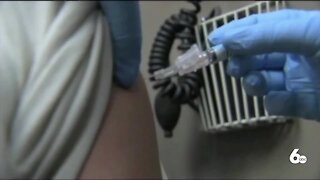Premium Only Content

<WARNING FACTS> - Covid, Election, Vaccines, Jan-6th And More...
PCR (polymerase chain reaction) is a method to analyze a short sequence of DNA (or RNA) even in samples containing only minute quantities of DNA or RNA. PCR is used to reproduce (amplify) selected sections of DNA or RNA.
Pfizer-BioNTech C O VID-19 Vaccine may not protect all vaccine recipients.
Adverse reactions following the Pfizer-BioNTech C O VID-19 Vaccine that have been reported in clinical trials include injection site pain, fatigue, headache, muscle pain, chills, joint pain, fever, injection site swelling, injection site redness, nausea, malaise, and lymphadenopathy (see Full EUA Prescribing Information). Severe allergic reactions have been reported following the Pfizer-BioNTech C O VID-19 Vaccine during mass vaccination outside of clinical trials. Additional adverse reactions, some of which may be serious, may become apparent with more widespread use of the Pfizer-BioNTech C O VID-19 Vaccine.
The Secretary of Health and Human Services (HHS) has declared a public health emergency that justifies the emergency use of drugs and biological products during the COVID-19 pandemic. In response, FDA has issued an EUA for the unapproved product, Pfizer-BioNTech C O VID-19 Vaccine, for active immunization against C O VID-19 in individuals 16 years of age and older.FDA issued this EUA, based on Pfizer-BioNTech’s request and submitted data.Although limited scientific information is available, based on the totality of the scientific evidence available to date, it is reasonable to believe that the Pfizer-BioNTech C O VID-19 Vaccine may be effective for the prevention of C O VID-19 in individuals as specified in the Full EUA Prescribing Information. This EUA for the Pfizer-BioNTech C O VID-19 Vaccine will end when the Secretary of HHS determines that the circumstances justifying the EUA no longer exist or when there is a change in the approval status of the product such that an EUA is no longer needed.
https://www.fda.gov/media/144413/download
The Elections Clause of the Constitution, Art. I, § 4, cl. 1, provides that “[t]he Times, Places and Manner of holding Elections for Senators and Representatives, shall be prescribed in each State by the Legislature thereof; but the Congress may at any time by Law make or alter such Regulations.” The Clause is a default provision; it invests the States with responsibility for the mechanics of congressional elections, see Storer v. Brown, 415 U. S. 724, 730 (1974), but only so far as Congress declines to pre-empt state legislative choices, see Roudebush v. Hartke, 405 U. S. 15, 24 (1972) (“Unless Congress acts, Art. I, § 4, empowers the States to regulate”). Thus it is well settled that the Elections Clause grants Congress “the power to override state regulations” by establishing uniform rules for federal elections, binding on the States. U. S. Term Limits, Inc. v. Thornton, 514 U. S. 779, 832-833 (1995). “[T]he regulations made by Congress are paramount to those made by the State legislature; and if they conflict therewith, the latter, so far as the conflict extends, ceases to be operative.” Ex parte Siebold, 100 U. S. 371, 384 (1880).
-
 0:25
0:25
WFTX
4 years agoCape Coral COVID vaccines
1.4K3 -
 1:45
1:45
WFTX
4 years agoNational updates on COVID and vaccines
614 -
 0:43
0:43
KIVI
4 years agoCVS Health to Start Administering COVID Vaccines
2771 -
 1:12:52
1:12:52
Kim Iversen
3 hours agoTucker Calls Out Israeli Blackmail — GOP Reels Into Civil War
87.1K96 -
 LIVE
LIVE
FusedAegisTV
12 hours agoYacht Boys Showing Out | Persona 5 Royal PART 18
70 watching -
 6:17:00
6:17:00
Dr Disrespect
9 hours ago🔴LIVE - DR DISRESPECT - PUBG - DANGEROUS
105K13 -
 57:19
57:19
Candace Show Podcast
3 hours agoTrump Gone Wild! Is Jeffrey Epstein Even Dead? | Candace Ep 215
96.8K227 -
 58:16
58:16
Redacted News
5 hours agoThe Secret Space Program IS REAL and this Whistleblower is EXPOSING all of it
47.5K181 -
 7:52:45
7:52:45
Viss
9 hours ago🔴LIVE - The 5 Wins PUBG Challenge! Viss w/ Dr Disrespect
21.7K -
 1:35:04
1:35:04
vivafrei
5 hours agoTrump Satisfied with Answers on Butler? Epstein Saga Continues! Douglass Mackey Special Guest!
165K53